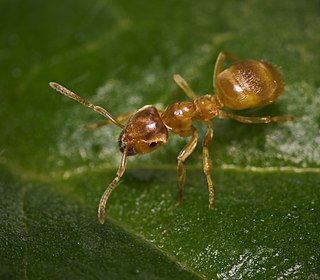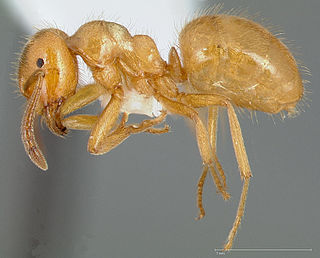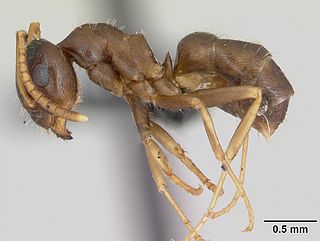
Lasius is a genus of formicine ants. The type species for this genus is the black garden ant, Lasius niger. Other major members, which live in drier heathland, are the cornfield ant, L. neoniger, and L. alienus. Other species include the temporary social parasites of the L. mixtus group and the hyper-social parasite Lasius fuliginosus. Lasius flavus is also a commonly seen species, building grassy hillocks in undisturbed pasture. In the Alps, these mounds – always aligned east to catch the first rays of the rising sun – have been traditionally used by goatherds as natural compasses. Species in the subgenus Acanthomyops, in particular L. interjectus and L. claviger, are commonly known as citronella ants due to their citronella-like smell.

The black garden ant, also known as the common black ant, is a formicine ant, the type species of the subgenus Lasius, which is found across Europe and in some parts of North America, South America, Asia and Australasia. The European species was split into two species; L. niger, which are found in open areas; and L. platythorax, which is found in forest habitats. It is monogynous, meaning colonies contain a single queen.

Blanford's rock agama is species of lizard in the family Agamidae. The species is endemic to Peninsular India. One of two species in the genus, P. blanfordanus is found mainly to the east of the distribution of P. dorsalis. Unlike the other species, the male P. blanfordanus in breeding season has the red body color restricted to the head and lacks the broad dorsal stripe.

The peninsular rock agama or South Indian rock agama is a common species of agama found on rocky hills in south India. An allied species, Psammophilus blanfordanus, is found in the Eastern Ghats, but north of the range of this species.

The yellow meadow ant, also known as the yellow hill ant, is a species of ant occurring in Europe, Asia, and North Africa. Populations in North America are now considered a different, related species, Lasius brevicornis.
The sand frog is a species of frog in the family Myobatrachidae. It is endemic to southern Western Australia. Its natural habitats are temperate forests, temperate shrubland, Mediterranean-type shrubby vegetation, shrub-dominated wetlands, swamps, intermittent freshwater lakes, and intermittent freshwater marshes.

Lasius latipes is a species of ant in the genus Lasius. It is native to the United States.
Lasius murphyi is a species of ant in the genus Lasius. It is endemic to the United States and Canada.
Lasius reginae is a species of ant in the genus Lasius. It is native to Austria.
The electric blue kande is a species of cichlid fish endemic to Lake Malawi where it prefers waters with a sandy substrate at depths of from 5 to 30 metres. It can reach a length of 11.6 centimetres (4.6 in) SL.

Lasius neglectus is a polygynous, sometimes invasive, ant of the genus Lasius. The ant was identified in 1990 after establishing a colony in Budapest, Hungary. Superficially, they are similar in appearance to the common black garden ant, Lasius niger, but have significantly different behavioural patterns, particularly in the social structure within colonies.

Lasius alienus, or cornfield ant, is a species of ant in the subfamily Formicinae. Workers have a length of about 2–4 mm, Queens are larger (7–9 mm).

Lasius fuliginosus, also known as the jet ant or jet black ant, is a species of ant in the subfamily Formicinae.

Formica cinerea is a species of ant in the family Formicidae.

Lasius claviger, or the smaller yellow ant, is a species of ant belonging to the genus Lasius, formerly a part of the genus Acanthomyops. Described in 1862 by Roger, the species is native to the United States.

Lasius neoniger, also known as the turfgrass ant, Labour day ant, cornfield ant or nuisance ant, is a species of ant in the genus Lasius. Found in North America, the species is common in the eastern United States and Canada, though they can be found all over the continent. They are usually light brown in color, with a slightly darker head.

Lasius brunneus is a species of ant in the genus Lasius. The species is widely distributed in Europe, from Sweden in the north to Anatolia in the south. In England this species is almost always found nesting in oak trees or rotting wood mainly foraging in trees but has also been found under stones and foraging on the ground. It is thought to be underrecorded but is fairly common especially in the South East.

Lasius grandis is a species of ant from the genus Lasius. The species was originally described by Forel in 1909. It occurs in the Mediterranean region of Europe and North Africa, more precisely in the Portuguese and Spanish mainland, in Andorra, the Azores, the Balearic Islands and Canary Islands.














